| Revision as of 04:38, 6 November 2018 edit2600:1700:5560:4750:8cd1:b1fb:fada:f000 (talk) Undid revision 867507447 by 2600:1700:5560:4750:8CD1:B1FB:FADA:F000 (talk)Tag: Undo← Previous edit | Revision as of 23:45, 6 May 2019 edit undoMichael Glass (talk | contribs)Extended confirmed users11,667 edits adjust convert templateNext edit → | ||
| Line 22: | Line 22: | ||
| ] (the ]) crosses the key at approximately mile markers 36-38.5, between ] and ] {{convert|12|mi|km}} west of ], close to the west end of the ]. | ] (the ]) crosses the key at approximately mile markers 36-38.5, between ] and ] {{convert|12|mi|km}} west of ], close to the west end of the ]. | ||
| The island is virtually uninhabited, being home to the {{convert|524|acre| |
The island is virtually uninhabited, being home to the {{convert|524|acre|ha|adj=on|abbr=off}} '''Bahia Honda State Park'''.<ref>{{cite book | last=Farren | first=R. | title=Highroad Guide to the Florida Keys and Everglades | publisher=John F Blair Pub | series=Highroad Guides | year=1999 | isbn=978-0-89587-280-7 | url=https://books.google.com/books?id=d1eFpaZDEOUC&pg=PA94 | access-date=September 7, 2017 | page=94}}</ref><ref name="Fodor's 2017"/> Founded in 1961, the park occupies most of the island.<ref name="Fodor's 2017"/> The channel at the island's west end is one of the deepest natural channels in the Florida Keys. | ||
| ==Fauna== | ==Fauna== | ||
Revision as of 23:45, 6 May 2019
For other uses, see Bahia Honda (disambiguation).| This article needs additional citations for verification. Please help improve this article by adding citations to reliable sources. Unsourced material may be challenged and removed. Find sources: "Bahia Honda Key" – news · newspapers · books · scholar · JSTOR (September 2017) (Learn how and when to remove this message) |
| Bahia Honda State Park | |
|---|---|
| IUCN category IV (habitat/species management area) | |
 Beach at Bahia Honda, looking east Beach at Bahia Honda, looking east | |
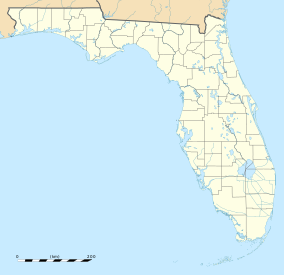 | |
| Location | Monroe County, Florida, United States |
| Nearest city | Marathon, Florida |
| Coordinates | 24°39′34″N 81°15′42″W / 24.659576°N 81.261578°W / 24.659576; -81.261578 |
| Area | 524 acres (2.12 km) |
| Established | 1961 |
| Governing body | Florida Department of Environmental Protection |
Bahia Honda (meaning deep bay, in Spanish, locally pronounced: BAY-ah HON-da , also pronounced Template:Es icon: Bah-EE-ah OWN-dah ) is an island in the lower Florida Keys.
U.S. 1 (the Overseas Highway) crosses the key at approximately mile markers 36-38.5, between Ohio Key and Spanish Harbor Key 12 miles (19 km) west of Marathon, close to the west end of the Seven Mile Bridge.
The island is virtually uninhabited, being home to the 524-acre (212-hectare) Bahia Honda State Park. Founded in 1961, the park occupies most of the island. The channel at the island's west end is one of the deepest natural channels in the Florida Keys.
Fauna
Marine life is quite plentiful in the waters surrounding the island. Just off the beach snorkelers can spot many species of small reef fish, as well as rays, barracuda, and even the occasional small nurse shark.
The only known natural colony of the now rare Miami blue butterfly was discovered in the park in 1999. The butterfly had been thought to have become extinct as a result of Hurricane Andrew in 1992.
Flora
Several rare plants, including yellow satinwood (Zanthoxylum flavum), Florida silver palm (Coccothrinax argentata), Coconut palm (Cocos nucifera), Key thatch palm (Leucothrinax morrisii), and the endangered small-flowered lily-thorn (Catesbaea parviflora) are found in the park
History
Henry Flagler's Florida East Coast Railway once ran through the present parkland to Key West. Built between 1905 and 1912, it was destroyed by the severe Labor Day Hurricane of 1935. Later, the railroad bridge foundations were used to build the Overseas Highway, which became U.S. 1. Part of the old Bahia Honda Bridge is accessible from the park, and offers a panoramic view of the islands. In 1908, the Florida East Coast Railway Company built two large two-story dormitories there to house workers building the Bahia Honda Bridge.
In 1890 Bahia Honda Key was the southern terminus for Miami-Dade county which stretched as far north as present day St. Lucie River.
Recreational activities
The 2.5-mile (4.0 km) natural, white sand beach was rated the #1 beach in 1992 in the United States by "Dr. Beach" Stephen Leatherman (the first Florida beach to be so honored), making it popular for swimming. A nature trail near the park's oceanside beach skirts a tidal lagoon before passing through a coastal hardwood hammock. Bicycling and inline skating can be done on the park's 3.5-mile (5.6 km) paved road, and there are several fishing and picnicking spots in the area. The Sand and Sea Nature Center features displays about local sea and shore life, including corals, shells, crabs, sea urchins, drift seeds, sea sponges and sea turtles.
Kayaks and snorkeling gear can be rented at the park, and boat trips for snorkeling on the reef are available. The park has a marina with boat slips available for overnight rental. Campsites (primitive and full hook-up) and vacation cabins are available, although reservations for the winter months can be very difficult to get.
The park is also a part of the Great Florida Birding Trail.
Hours
Florida state parks are open between 8 a.m. and sundown every day of the year (including holidays).
Gallery
-
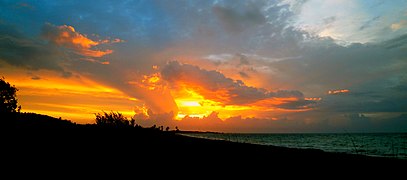 View of the sunrise
View of the sunrise
-
 View of the Bahia Honda Rail Bridge from Bahia Honda State Park
View of the Bahia Honda Rail Bridge from Bahia Honda State Park
-
 Sunset through the Old Bridge
Sunset through the Old Bridge
-
 Magnificent frigatebird
Magnificent frigatebird
-
 Bahia Honda State Park – Old Railroad Bridge
Bahia Honda State Park – Old Railroad Bridge
-
 Old Railroad Bridge
Old Railroad Bridge
-
 Old Railroad Bridge – view of trusses
Old Railroad Bridge – view of trusses
-
 Bottlenose dolphins swimming just off the beach
Bottlenose dolphins swimming just off the beach
-
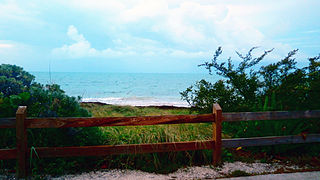 Morning view of beach
Morning view of beach
-
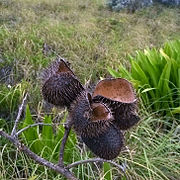 Dry seed pods
Dry seed pods
-
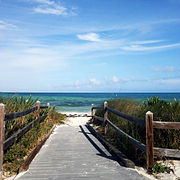 Beach access
Beach access
-
View in direction of Gulf of Mexico
-
Sunset
-
 Panoramic view of the Bahia Honda Key and the park from the bridge
Panoramic view of the Bahia Honda Key and the park from the bridge
References
- Farren, R. (1999). Highroad Guide to the Florida Keys and Everglades. Highroad Guides. John F Blair Pub. p. 94. ISBN 978-0-89587-280-7. Retrieved September 7, 2017.
- ^ Fodor's In Focus Florida Keys: with Key West, Marathon & Key Largo. Travel Guide. Fodor's Travel. 2017. p. pt120–122. ISBN 978-0-14-754675-3. Retrieved September 7, 2017.
External links
Categories:- IUCN Category IV
- Beaches of Monroe County, Florida
- State parks of Florida
- Parks in the Florida Keys
- Uninhabited islands of Monroe County, Florida
- Tourist attractions in the Florida Keys
- Protected areas established in 1961
- Parks in Monroe County, Florida
- Nature centers in Florida
- Beaches of Florida
- Islands of Florida